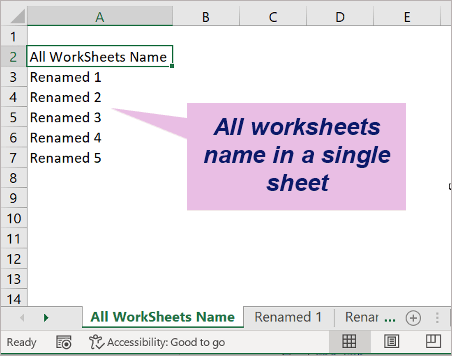How To Rename Specific Sheet In Excel

Manipulating Excel sheets is a fundamental skill for anyone dealing with data. One such task is renaming a specific sheet in a workbook, which might seem straightforward but involves a few nuances for accuracy and efficiency.
Why Rename Excel Sheets?

Renaming sheets in Excel helps in:
- Organizing data: Clear sheet names make navigation easier.
- Ensuring consistency: Uniform naming conventions across multiple workbooks.
- Improving readability: Using descriptive names for easier data recognition.
How to Rename a Sheet in Excel

Here are the steps to rename a specific sheet:
Open the Excel workbook containing the sheet you want to rename.
Locate the sheet tab at the bottom of the Excel interface.
Right-click on the tab you wish to rename. A context menu will appear.
Select Rename from the menu. The sheet name will become editable.
Type the new name for the sheet, ensuring no existing sheet has the same name within the workbook.
Press Enter or click outside the text box to confirm the new name.
💡 Note: Sheet names must be unique and cannot contain certain characters such as “/” or “:”.
Using VBA to Rename Sheets

For those dealing with multiple sheets or for automation, VBA (Visual Basic for Applications) can be used to rename sheets:
Press Alt + F11 to open the VBA editor.
Insert a new module by right-clicking on any open module in the Project Explorer, selecting Insert, then Module.
Type or paste the following VBA code:
Sub RenameSpecificSheet()
Dim ws As Worksheet
Dim newName As String
'Change the sheet name here
newName = "NewSheetName"
For Each ws In ThisWorkbook.Worksheets
If ws.Name = "Sheet1" Then 'Specify the current name of the sheet here
ws.Name = newName
Exit Sub
End If
Next ws
MsgBox "Sheet not found or already renamed!"
End Sub
After entering the code, run the macro by pressing F5.
Tips for Renaming Sheets

Be Mindful of Limitations: Excel limits sheet names to 31 characters and prohibits the use of certain characters.
Use VBA for Batch Renaming: VBA can rename multiple sheets efficiently, especially when following a specific pattern or rule.
Consistency in Naming: Adopt a naming convention that reflects the data or purpose of the sheet for better organization.
Understanding how to rename sheets is just a small part of Excel's vast array of features, but mastering this skill enhances productivity and data management in significant ways. Each workbook you work with can become a better organized and more intuitive tool for data analysis and reporting.
What should I do if renaming a sheet results in an error?

+
If renaming leads to an error, ensure the new name isn’t already in use, doesn’t exceed 31 characters, and avoids restricted characters like “:”, “/”, “?”, or “\”.
Can I rename multiple sheets at once in Excel?

+
Yes, by using VBA, you can write a script to rename several sheets based on certain criteria or conditions. Manual renaming is limited to one sheet at a time.
What’s the benefit of using descriptive sheet names?

+
Descriptive names help in quickly identifying the content of each sheet, making navigation and data management within large workbooks much more efficient.